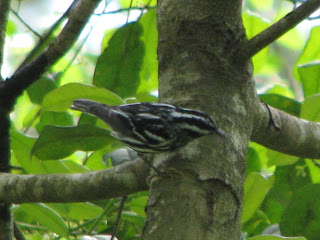
Black and White Warbler
We've been so busy with many conservation efforts, that I haven't had time to write anything for months. So.... this will probably be a long post.
Our
nest box trail is doing well this spring. There are 5 boxes occupied with Carolina Chickadees and 1 with Eastern Bluebirds. We plan to check the boxes again tomorrow, if it doesn't rain. All the eggs that were laid when we last checked, have hatched and we've observed the bluebirds feeding their young.
We've had an abundance of rain (all at one time) this year. Recently we received almost 7 inches in 2 days. We are no longer below the average rainfall, but the deluge was followed by several days of strong winds which dried everything out, so we really could use another rain.
The strong winds continue to break tree limbs that were damaged during the December snowstorm and the hurricanes. We are constantly clearing trails in the woods and in our yard.
We've seen some interesting and beautiful animals and birds recently. Yesterday, while we were down by the river, we observed a Black and White Warbler,
Prothonotary Warbler, Pileated and other
Woodpeckers, and several Wood Ducks. Indigo Buntings and some other migratory birds have been visiting the feeders near the house.
A few days ago, Al saw a mother Wood Duck and 15 ducklings in our pond by the house. Apparently they had hatched from the box that we put up there. By the time he had put the dogs inside and grabbed his camera, they were gone. Those mother Wood Ducks are like drill Sergeants. She lined them all up and led them far away to the other side of the pond from Al, then as soon as he left, she must have taken them into the bushes and told them to lie low.
Late yesterday afternoon, I was looking out of the French doors in the front of the house and was surprised and pleased to see a Wild Turkey cautiously stroll into the gravel part of the circular drive. She (I think) was looking straight at me so I couldn't move. I asked Al to get the camera, but by the time he found it, the turkey had stepped back behind some bushes. I went out and did see it walking toward the wetlands area by HWY 190, but couldn't get a photo. Even though we haven't been able to photograph the Wild Turkeys, it's great to know that there are still some around. With all the habitat destruction and urban sprawl, the large tracts of land that are needed for these large birds have been cut into small islands, which reduces the population that can be supported.
